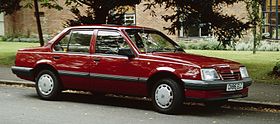| J-body | |
|---|---|
 A 1987 Vauxhall Cavalier, the Vauxhall version of the GM J-body. | |
| Overview | |
| Manufacturer | General Motors |
| Production | 1981–2005 |
| Body and chassis | |
| Class | Compact (North America) Mid-size (Global) |
| Layout | Transverse front-engine, front-wheel drive |
| Body style(s) | 2-door convertible 2-door coupe 2-door notchback sedan 3-door hatchback 4-door sedan 5-door station wagon 5-door hatchback |
| Chronology | |
| Predecessor | GM H platform (RWD) (North America) |
| Successor | GM2900 platform (Europe) GM Delta (North America) |
The General Motors J platform, or J-body, is an automobile platform that was used by General Motors for compact cars from the 1982 to 2005 model years. The third generation of compact cars designed by GM, the J-body marked the introduction of front-wheel drive for its compact model lines, simultaneously replacing the rear-wheel drive H-body and the European U-body platforms, the latter being a stretched version of the original rear-wheel drive T-body. The J-body was marketed as a world car, with GM brands selling versions of the platform in North America, Europe, Australia, and Japan; in markets outside of North America, the model line was packaged as a mid-size car.
Outside North America, the use of the J platform was phased out after the 1980s in favor of the Opel-based GM2900 platform. In North America, the introduction of the Saturn S-Series would lead to the consolidation of the J-body to the Chevrolet and Pontiac brands.
Following several major revisions, the J platform remained in use into the 21st century; in June 2005, the final example (a Pontiac Sunfire) was produced. Introduced by Saturn for 2003, the GM Delta platform is the fourth generation of compact cars from General Motors.